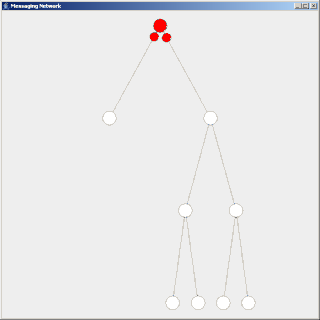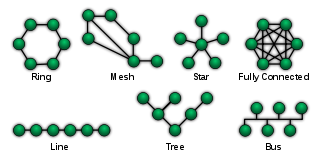Related Research Articles
Routing is the process of selecting a path for traffic in a network or between or across multiple networks. Broadly, routing is performed in many types of networks, including circuit-switched networks, such as the public switched telephone network (PSTN), and computer networks, such as the Internet.

In computing, a denial-of-service attack is a cyber-attack in which the perpetrator seeks to make a machine or network resource unavailable to its intended users by temporarily or indefinitely disrupting services of a host connected to a network. Denial of service is typically accomplished by flooding the targeted machine or resource with superfluous requests in an attempt to overload systems and prevent some or all legitimate requests from being fulfilled.
An intrusion detection system is a device or software application that monitors a network or systems for malicious activity or policy violations. Any intrusion activity or violation is typically reported either to an administrator or collected centrally using a security information and event management (SIEM) system. A SIEM system combines outputs from multiple sources and uses alarm filtering techniques to distinguish malicious activity from false alarms.

A wireless mesh network (WMN) is a communications network made up of radio nodes organized in a mesh topology. It can also be a form of wireless ad hoc network.

The Optimized Link State Routing Protocol (OLSR) is an IP routing protocol optimized for mobile ad hoc networks, which can also be used on other wireless ad hoc networks. OLSR is a proactive link-state routing protocol, which uses hello and topology control (TC) messages to discover and then disseminate link state information throughout the mobile ad hoc network. Individual nodes use this topology information to compute next hop destinations for all nodes in the network using shortest hop forwarding paths.
Ad hoc On-Demand Distance Vector (AODV) Routing is a routing protocol for mobile ad hoc networks (MANETs) and other wireless ad hoc networks. It was jointly developed by Charles Perkins and Elizabeth Royer and was first published in the ACM 2nd IEEE Workshop on Mobile Computing Systems and Applications in February 1999.
In computer network research, network simulation is a technique whereby a software program replicates the behavior of a real network. This is achieved by calculating the interactions between the different network entities such as routers, switches, nodes, access points, links, etc. Most simulators use discrete event simulation in which the modeling of systems in which state variables change at discrete points in time. The behavior of the network and the various applications and services it supports can then be observed in a test lab; various attributes of the environment can also be modified in a controlled manner to assess how the network/protocols would behave under different conditions.

Wireless security is the prevention of unauthorized access or damage to computers or data using wireless networks, which include Wi-Fi networks. The term may also refer to the protection of the wireless network itself from adversaries seeking to damage the confidentiality, integrity, or availability of the network. The most common type is Wi-Fi security, which includes Wired Equivalent Privacy (WEP) and Wi-Fi Protected Access (WPA). WEP is an old IEEE 802.11 standard from 1997. It is a notoriously weak security standard: the password it uses can often be cracked in a few minutes with a basic laptop computer and widely available software tools. WEP was superseded in 2003 by WPA, a quick alternative at the time to improve security over WEP. The current standard is WPA2; some hardware cannot support WPA2 without firmware upgrade or replacement. WPA2 uses an encryption device that encrypts the network with a 256-bit key; the longer key length improves security over WEP. Enterprises often enforce security using a certificate-based system to authenticate the connecting device, following the standard 802.11X.
Packet loss occurs when one or more packets of data travelling across a computer network fail to reach their destination. Packet loss is either caused by errors in data transmission, typically across wireless networks, or network congestion. Packet loss is measured as a percentage of packets lost with respect to packets sent.

Flooding is used in computer network routing algorithms in which every incoming packet is sent through every outgoing link except the one it arrived on.
In networking, a black hole, also known as a block hole, refers to a place in the network where incoming or outgoing traffic is silently discarded, without informing the source that the data did not reach its intended recipient.
In computing, a wireless intrusion prevention system (WIPS) is a network device that monitors the radio spectrum for the presence of unauthorized access points (intrusion detection), and can automatically take countermeasures (intrusion prevention).
A wireless ad hoc network (WANET) or mobile ad hoc network (MANET) is a decentralized type of wireless network. The network is ad hoc because it does not rely on a pre-existing infrastructure, such as routers or wireless access points. Instead, each node participates in routing by forwarding data for other nodes. The determination of which nodes forward data is made dynamically on the basis of network connectivity and the routing algorithm in use.
A broadcast storm or broadcast radiation is the accumulation of broadcast and multicast traffic on a computer network. Extreme amounts of broadcast traffic constitute a broadcast storm. It can consume sufficient network resources so as to render the network unable to transport normal traffic. A packet that induces such a storm is occasionally nicknamed a Chernobyl packet.
Multipath routing is a routing technique simultaneously using multiple alternative paths through a network. This can yield a variety of benefits such as fault tolerance, increased bandwidth, and improved security.

Network forensics is a sub-branch of digital forensics relating to the monitoring and analysis of computer network traffic for the purposes of information gathering, legal evidence, or intrusion detection. Unlike other areas of digital forensics, network investigations deal with volatile and dynamic information. Network traffic is transmitted and then lost, so network forensics is often a pro-active investigation.
A distributed firewall is a security application on a host machine of a network that protects the servers and user machines of its enterprise's networks against unwanted intrusion. A firewall is a system or group of systems that implements a set of security rules to enforce access control between two networks to protect the "inside" network from the "outside" network. They filter all traffic regardless of its origin—the Internet or the internal network. Usually deployed behind the traditional firewall, they provide a second layer of defense. The advantages of the distributed firewall allow security rules (policies) to be defined and pushed out on an enterprise-wide basis, which is necessary for larger enterprises.
Vehicular Ad hoc Networks (VANETs) is a network protocol designed for traffic safety applications. As other computer network protocols, it is also subject to several attacks that can have fatal consequences due to the VANET's intended usage. One of these possible attacks is location spoofing where the attacker is lying about a vehicle's position to disrupt VANET safety application. This attack can be performed either through existent vehicles or forging new identities by a Sybil attack. There are several publications that propose mechanisms to detect and correct malicious location advertisements. This article presents an overview of some of these verification mechanisms proposed in the literature.
Associativity-based routing is a mobile routing protocol invented for wireless ad hoc networks, also known as mobile ad hoc networks (MANETs) and wireless mesh networks. ABR was invented in 1993, filed for a U.S. patent in 1996, and granted the patent in 1999. ABR was invented by Chai Keong Toh while doing his Ph.D. at Cambridge University.
References
- 1 2 Zhang, Xiaobing; et al. (2000). "Malicious packet dropping: how it might impact the TCP performance and how we can detect it" (PDF). Icmp: 263.
- ↑ Al-Shurman, Mohammad; et al. "Black Hole Attack in Mobile Ad Hoc Networks" (PDF). Archived from the original (PDF) on 2013-12-28. Retrieved 2013-04-07.
- ↑ Wang, Weichao. "Defending against Collaborative Packet Drop Attacks on MANETs" (PDF). Retrieved 2011-05-05.